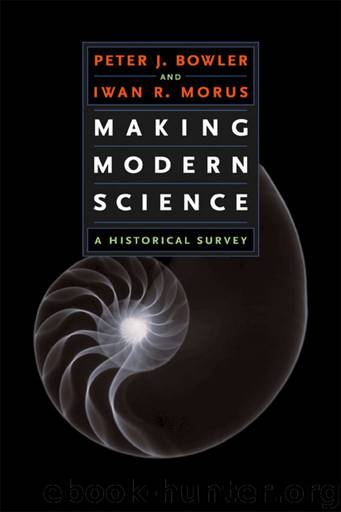Making Modern Science: A Historical Survey by Peter J. Bowler & Iwan Rhys Morus

Author:Peter J. Bowler & Iwan Rhys Morus [Bowler, Peter J.]
Language: eng
Format: azw3
Publisher: University of Chicago Press
Published: 2010-02-24T05:00:00+00:00
FIGURE 11.3 Niels Bohr’s model of the hydrogen atom in which an electron could only orbit the central nucleus in orbits defined by Planck’s Constant, h.
A young Danish physicist, Niels Bohr, suggested a solution to this problem. Bohr had worked with Thomson at the Cavendish and with Rutherford at Manchester. In 1913, Bohr suggested a model of atomic structure very similar to that proposed by Rutherford, but with one important difference. Bohr suggested that the electrons orbiting the central nucleus could only release their energy in distinct packets of energy, each with a distinctive frequency (fig. 11.3). This was how he solved the problem of atomic stability. The electrons orbiting the nucleus were not radiating continuously, they only did so at particular frequencies. Bohr was picking up on an idea first formulated by the German physicist Max Planck (of whom more later in this chapter) that energy could be released in quanta (i.e., discrete packets) defined by a constant factor—called Planck’s constant (h) after its inventor. Albert Einstein had already made use of Planck’s constant to argue that light could be treated as particles, each with an energy defined by the light frequency multiplied by h. What Bohr suggested was that atoms could exist in a number of stable states, each defined as a multiple of h. They only released energy when they changed from one state to another, and the energy they released in that process was a multiple of h and their change of frequency.
One crucial feature of Bohr’s model of atomic structure was that it provided an explanation for the distinctive emission and absorption spectra of the different elements. It had been known for decades that the elements had distinctive spectra like this—different elements showed distinct dark lines in particular parts of the spectrum. This was how physicists used spectroscopy to identify the elements making up different substances: by comparing a sample to known elements and comparing their spectra they could use the spectral lines to identify the unknown elements. According to Bohr’s model, this was because the individual atoms making up an element only vibrated at particular frequencies, corresponding to the spectral lines. In particular, Bohr’s model explained Balmer’s formula—an empirically derived formula worked out by the Swiss mathematician Johann Balmer showing that the position of these lines in the spectrum followed a regular pattern. Bohr managed to show that his equations fit the Balmer formula as well. The Rydberg Constant governing the relationship between the spectral lines was shown by Bohr to be itself a derivative of Planck’s constant. Bohr had succeeded in bringing together the theory of discontinuous radiation pioneered by Planck and Rutherford’s model of atomic structure. There was only one problem with the theory. It violated most of the then accepted laws of physics. British physicists such as Lord Rayleigh—J. J. Thomson’s predecessor at the Cavendish—were unhappy with the introduction of the mysterious quantum. German theoretical physicists who had accepted Planck’s views on the quantum of energy were unhappy with the idea
Download
This site does not store any files on its server. We only index and link to content provided by other sites. Please contact the content providers to delete copyright contents if any and email us, we'll remove relevant links or contents immediately.
Enlightenment Now: The Case for Reason, Science, Humanism, and Progress by Steven Pinker(7272)
A Journey Through Charms and Defence Against the Dark Arts (Harry Potter: A Journey Through…) by Pottermore Publishing(4789)
The Immortal Life of Henrietta Lacks by Rebecca Skloot(4548)
A Journey Through Divination and Astronomy by Publishing Pottermore(4363)
Elon Musk by Ashlee Vance(4084)
Origin Story: A Big History of Everything by David Christian(3666)
COSMOS by Carl Sagan(3588)
Alchemy and Alchemists by C. J. S. Thompson(3481)
Bad Pharma by Ben Goldacre(3396)
Enlightenment Now by Steven Pinker(3349)
Shadow of Night by Deborah Harkness(3324)
Inferior by Angela Saini(3293)
A Mind For Numbers: How to Excel at Math and Science (Even If You Flunked Algebra) by Barbara Oakley(3256)
Origin Story by David Christian(3170)
The Code Book by Simon Singh(3136)
Signature in the Cell: DNA and the Evidence for Intelligent Design by Stephen C. Meyer(3098)
The Elements by Theodore Gray(3025)
A Brief History of Time by Stephen Hawking(2991)
A Journey Through Potions and Herbology (A Journey Through…) by Pottermore Publishing(2836)
